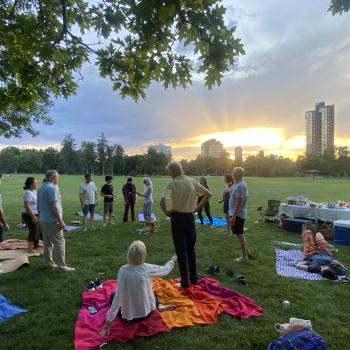Myths in Motion: How Ancient Religious Tales Shaped Contemporary Traditions
By Mona Moayedi
During the past quarters, we organized two community events for the Myths in Motion project—Nowruz (Spring Equinox) and Tirgan (Summer Solstice)— with Sarv Center, under the supervision of Dr. Poupeh Missaghi, each lasting approximately three hours and designed to explore how ancient religious myths continue to shape modern- day celebrations. These gatherings brought together community members of diverse ethnic backgrounds to share, move, create, and reflect on the myths behind their seasonal traditions.
The Nowruz (Persian word for Iranian New Year, meaning New Day) event centered on storytelling and collective participation. Participants shared stories of ancestral New Year rituals before major religions reshaped their calendars. Iranians recounted the myth of King Jamshid and the rebirth of light, while others spoke about spring celebrations in their cultures, such as the Celtic Beltane or the Babylonian Akitu. Some participants stated they had never thought about the stories behind their New Year's event; most of them (non-Westerners) admitted that they didn't know what their ethnic New Year's time and its story were before the Christian New Year calendar. The event included a part of gentle breathing and body movements inspired by seasonal renewal—guided sequences synchronized with music that evoked the awakening of nature. Participants also made crafts using seeds, threads, and mirrors, symbolic of growth and reflection, while exchanging stories. These shared activities built friendship, sparking laughter and deep conversation about how myths continue to echo in cultural memory.
The Tirgan celebration, held outdoors, gathered about 20 attendees in Cheesman Park. This festival, rooted in the myth of Tishtara, the rain-bringing deity, and Arash the Archer, who sacrificed himself to restore peace, provided a lens into Iran’s summer solstice traditions. We recreated symbolic rituals: participants tied rainbow-colored bands to their wrists and took part in guided breathing and body movements inspired by wind, water, and sunlight. The event organically became a story circle, where attendees shared similar myths from their own cultures—stories of rain gods, harvest rituals, and sun festivals. Through movement, craft, and storytelling, participants connected to one another and to nature, embodying the project’s goal of turning myth into lived experience. The participants were asked to bring the stories of their cultures related to the summer solstice. Some participants stated that they didn't know if their culture had such myths, but they shared the traditions of celebrating the summer when they were little. Most of the non-Western participants shared intriguing myths and stories of their summer solstice celebration in their cultures.
The most powerful outcome of these events was the transformation in participants’ self-awareness and connection to others. Many shared afterward that they had never deeply reflected on the myths or ancestral traditions of their own cultures, or never knew that many secular celebrations of the modern day had mythical and religious connotations in the past. Engaging with these stories—and seeing how others had similar myths—made them curious to learn more, not just about Iran or ancient rituals, but about their own roots. Participants described feeling more confident and proud of their identity, yet also more empathetic and respectful toward cultures they previously knew little about, particularly those often marginalized or undervalued in Western discourse.
Several attendees expressed that the events helped them realize how interconnected world cultures truly are, especially through archetypes and natural cycles—birth, death, renewal, rain, drought, and light. These realizations echoed Mircea Eliade’s concept of collective consciousness and the eternal return: the idea that through ritual and myth, communities re-enter sacred time and rediscover shared humanity.
Beyond an academic project for us, these gatherings became spaces of genuine human connection between people from very diverse ages and ethnic backgrounds. Strangers listened to one another with curiosity; they left with a sense of belonging to a larger, ancient narrative that continues to unite us through the language of myth today in the form of national and international celebrations.
This project showed that the myths are always in motion; these ancient religious stories shape and maintain universal traditions. It also proved how storytelling and embodied ritual can rebuild community bonds. The stories, reflections, and recordings from these events will be included in my future papers and dissertation, deepening my study of living myths and collective identity.
